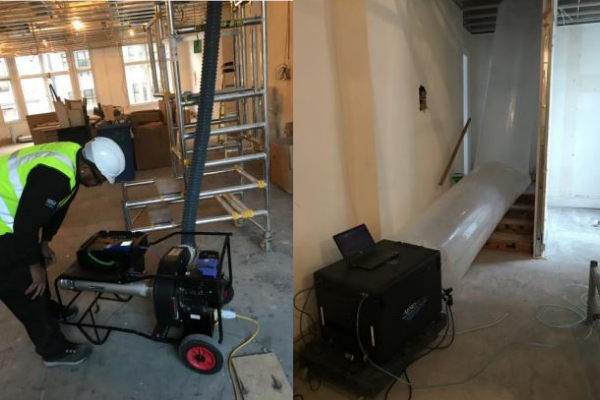Why leakage testing is a must for HVAC systems

Leakage testing is standard practice for most HVAC systems. While it can be one of the easiest maintenance tasks to complete, many home and business owners skip it entirely
How much does it cost to test an HVAC system for leaks?
Various factors will influence the cost of HVAC leakage testing. You’ll need to know how much time is involved with HVAC leakage testing, what parts are necessary for the job, and the labour costs for the company doing the work. This article will look at what HVAC leakage testing is, why it’s so important, and how it can help you save money down the road.
What is HVAC leakage testing?
HVAC leakage testing is a service performed on your heating and cooling system to determine if there are any leaks. A leak, in this case, is any fluid or air escaping from an HVAC system through a hole or crack. Leaks can occur in the ducts, pipes, and other components that make up the inside of the HVAC system. Here are three reasons why air duct leakage testing is a must:
Improved safety
A tiny amount of air leakage from your HVAC system could cause the system to blow dust and allergens around your home, creating a health hazard. It can also cause carbon monoxide (CO) poisoning, which can be fatal. A faulty HVAC system can also lead to moisture damage, which can undermine your home’s structural integrity and, even worse, cause it to collapse!
Maximising the system’s lifespan
The importance of HVAC leakage testing is twofold: spotting minor problems before they become major ones and maximising the system’s lifespan. If a small leak isn’t addressed early on, it can cause much more extensive damage down the road. It can also result in the system becoming completely unusable.
Saving money
A single hole or crack in your HVAC system can lead to substantial financial losses that could have been easily prevented. These leaks also contribute to higher utility costs by allowing outside air into the system. Therefore, catching and fixing a leak before it becomes a significant problem will save money and labour in the long run.
The process of leakage testing
Detecting HVAC system leaks can be difficult, but it doesn’t have to be. Here are a few ways to check for leaks in your system.
Visual inspection
A visual inspection of the unit can sometimes reveal signs of a leak, such as a wet coil or condensation on non-insulated pipes. It is important to note that a visual inspection can only reveal leaks where water vapour is visible. If there is no water vapour, the leak will not be visible from this inspection.
Soap bubble solution
Mix dish detergent with water in a spray bottle. Spray the solution onto the suspected refrigerant leaks in your air conditioner. When you notice frothy bubbles, that’s an indication there’s a refrigerant leak.
Electronic leak detection method
Electronic leak detectors use ultrasonic technology to detect leaks, which are more precise than traditional methods. When a leak is detected, the detector makes a sound that can be heard over the noise of the HVAC system. A specialist decodes these sound waves to trace the leak source.
Fluorescent leak detection dye method
Fluorescent leak detection dye solution is a non-invasive way to locate leaks in your HVAC system. It uses a specialised fluorescent dye to trace the path of a fluid as it moves through the HVAC system.
The dye is injected into the ducts of an HVAC system, and then, using ultraviolet light, technicians can see where the dye has leaked out. When the ultraviolet light is shone on the HVAC system, leaks appear as fluorescent green or yellow spots.
Unlike other leak detection methods such as smoke detectors or chemical sprays that can be toxic, UV lights don’t contain any harmful fumes, vapours, chemicals, or other harsh substances.
However, dyes are difficult to remove and can gradually deteriorate certain components of your HVAC system.
Using Aeroseal for air duct sealing
When it comes to air duct sealing, there’s one name that comes up more than any other: Aeroseal. Although there are many methods for eliminating leaks, many are costly and inconvenient. For example, while adding insulation to the ducts is an effective method, it is time-consuming and requires extensive labour. You might also need to remove furniture from the rooms where you want to add insulation.
Aeroseal is a brand of sealant used to create airtight seals in air ducts. The sealant includes vinyl acetate, a nontoxic polymer that is approved for use by UL.
It has several advantages over traditional sealants, including being nontoxic and having the ability to be used in flex ducts.
Frequently Asked Questions (FAQs)
Can I test my HVAC system for leaks without professional assistance?
You might be thinking, “I’m pretty good at spotting leaks.” And we’re pretty sure you are. But since these leaks aren’t apparent to the naked eye, it’s wise to make an appointment with a certified HVAC specialist to come and take a look at your HVAC system.
How much does it cost to test an HVAC system for leaks?
There are a lot of factors that go into how much the process will cost. You’ll need to know how much time is involved with testing, what parts are necessary for the job, and the labour costs for the company doing the work.
What are the signs of hidden HVAC leaks?
A few signs that your air conditioner may have a hidden leak include:
• Your unit uses more energy than it should
• There is a “musty” smell in your building
• You hear a hissing sound when you turn on your air conditioner
• You’ve seen mould around your building
• You see condensation on the sides of your home
• You notice stains on the ceiling of your basement
What tools do we use to test for leaks in an HVAC system?
The equipment needed to perform a leak detection test will vary depending on your HVAC system. That said, most tests require a thermal imaging camera. This camera takes high-definition thermal images of your ductwork and coils that are then analysed by a technician, who identifies any leaks and pinpoints their location.
If you’re looking for a way to save energy and improve the indoor air quality of your building, look no further than Hasman’s line of Aeroseal products! Contact us today, or explore the website for more information.




